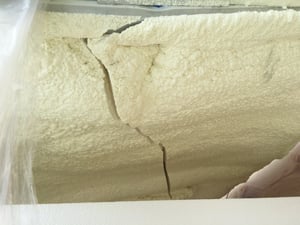Installing a backflow preventer outside and above ground is the safest and most cost-effective way to do it. But if you live in a cold-weather climate, you need to house it in an insulated backflow enclosure. Be sure to pay attention to the type of insulation you’re getting.
Spray Foam Has Limitations
Enclosures for backflow prevention assemblies that are insulated with spray foam are good, but spray foam has short-term and long-term issues.
- Spray Foam Isn’t Thick Enough: Manufacturers can have a tough time determining the proper thickness of the insulation. It can vary from enclosure to enclosure. Unfortunately, good average thickness doesn't cut it. The coverage needs to be uniform because a lot of heat will go through the under-insulated areas. And enclosure manufacturers that use spray foam do not provide R18 in the roof.
- Air Leakage Sites Can Be Missed: It's important to seal the envelope completely. One of spray foam's biggest selling points is its air-sealing ability, but it can't seal places where it isn’t sprayed.
- Spray Foam Pulls Away or Cracks: During shipping, installation and over time, spray foam has been known to crack, break and pull away from the walls of a backflow enclosure. When the insulation starts to break down, so does the protection it’s supposed to offer your backflow preventer.

Every part of your enclosure must be insulated at all times for maximum protection.
Insulated Backflow Enclosure Panels
If the panels of your backflow enclosure have 1½” of polyisocyanurate insulation cut to the exact dimensions of the panel, your backflow preventer is in a good place. That’s because this material is commonly used in the roofing industry and is superior to the sprayed-on insulation typically used by other enclosure manufacturers.
The R-value for polyisocyanurate insulation is the highest for rigid-board insulation at an average of 6.5 per inch and more than meets the R-8 requirement achieve ASSE 1060 certification. This insulation is fastened within each panel, as well as the roof panels, which means it will stay in place during the shipping, installation and over time.
Added Bonus: Insulation Offers Noise Reduction
In addition to keeping your equipment warm, a properly insulated backflow enclosure will help keep the noise down. The noise reduction coefficient is the combination of the thickness and density of a product. The NRC lets you know how much noise will be absorbed by the material.
Using 1.5"-thick CFAB Cellulose Panels, which have a .85 NRC rating, means they will absorb 85% of noise passing through them.
CFAB panels are innovative. They’re made with a cellulose-based material, which is the first of its kind in our industry. It’s made up of 65-75% recycled content. CFAB cellulose products represent an environmentally-responsible solution for acoustical materials. This cellulose soundproofing insulation is an inventive, yet sustainable alternative to traditional fiberglass and synthetic acoustical or thermal panels, which are unreliable performers in a variety of different applications. In addition to controlling and deadening the sound coming from inside your backflow enclosure, CFAB panels will also do things like:
- Reduce airborne sound transmission
- Block outdoor noise
- Easy to handle and install – no special equipment required
- Comes with a Class A fire rating
- Resists mold growth
Noise reduction is not only important for backflow preventers but for equipment like HVAC pumps, compressors and generators, too. They can produce quite a bit of noise. This can create a safety and health issue if workers are working nearby. Insulation is key in this situation.
Safe-T-Cover Insulated Backflow Enclosures
We fit our enclosures with 1½” of polyisocyanurate insulation, cut to the exact dimensions of the panel. They’re also fitted with 3" of rigid-board insulation in the roof.
If you’re installing a backflow preventer above ground and outdoors, make sure it’s surrounded by the best insulation your money can buy. You can offer even more protection by adding a heater. Our proprietary slab-mounted heater will maintain at least a 40-degrees Fahrenheit temperature inside when the outside temperature is as low as negative 30 degrees Fahrenheit. It will also heat your pipes. Watch this video to see how it works.




